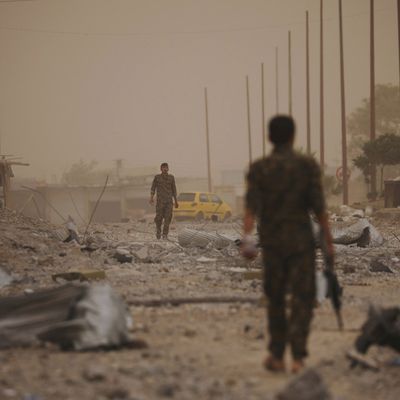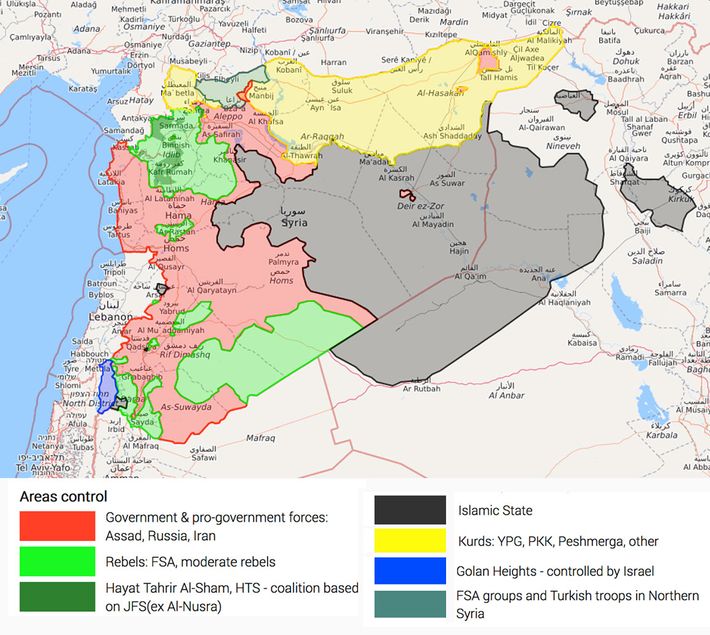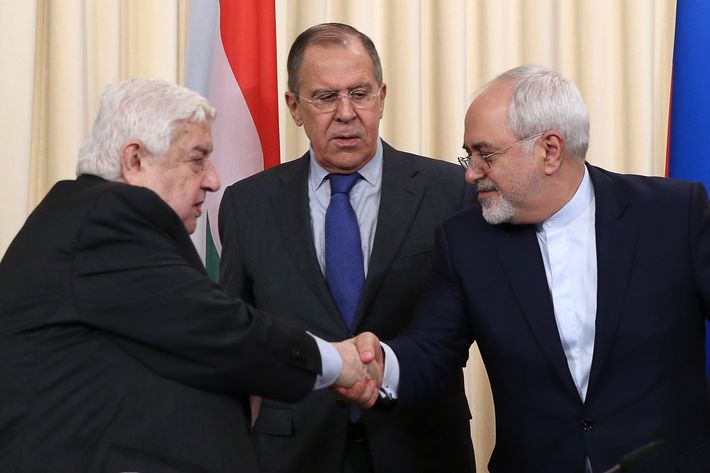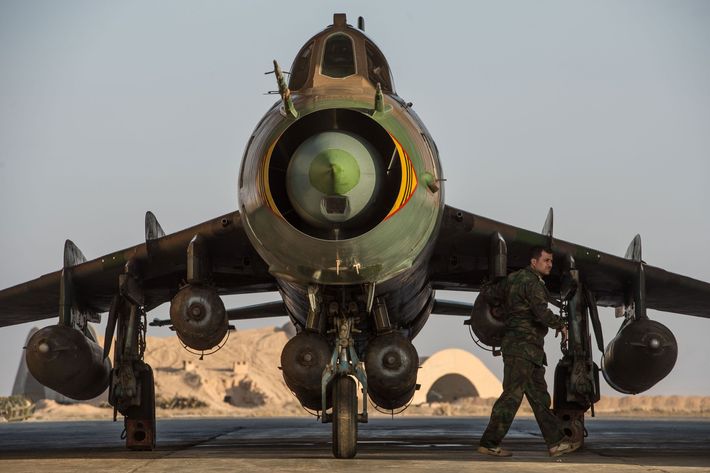
On Tuesday, a United States F-15 fighter jet shot down an Iranian-made armed drone near al-Tanf, an area in southeastern Syria that meets the borders of Iraq and Jordan. It was the second time this month, in nearly the exact location, that the U.S. military downed a similar craft of Iranian make. One had allegedly attempted to open fire on coalition forces. Over the weekend, the United States felled a Syrian air jet in the eastern part of the country. It marked the first time American forces had engaged in air-to-air combat since 1999. Russia, a strong backer of the Syrian government, threatened to shoot down American aircraft west of the Euphrates River, making it seem as if two nuclear superpowers could be careening toward confrontation.
This has always been the daunting nature of the Syrian conflict: many powers, large and small, operating in close quarters and competing for deeply felt interests. The one thing United States and Russia and their respective allies could agree on — at least in theory — was the need to take out the Islamic State. But that common ground is proving less and less unifying, especially now that the extremists are losing big swaths of territory. That makes even more urgent the looming question of who ultimately gets to control Syria, says Nader Hashemi, the director of the Center for Middle East Studies at the Josef Korbel School of International Studies at the University of Denver. Hashemi’s latest book, Sectarianization, examines the forces behind some of the region’s messiest conflicts. In conversation with Daily Intelligencer, he explains how the war in Syria — and the related risks facing the United States — are changing.
How significant is the action the United States military took in shooting down the Syrian warplane?
I think it’s extremely significant. The last time the United States shot down a plane was in the Kosovo War. Syria has been destabilizing our world for the last six years, and now we’re seeing another source of destabilization: where it seems like the United States and Russia are headed toward some sort of military conflict. They’re backing opposite sides, and there is a major scramble for territory as the so-called Islamic State is on its last legs. The big question now is who’s going to control the territory ISIS used to control.
So as ISIS loses ground, it’s a fight for the spoils. Is that a fair assessment?
ISIS is about to be defeated in Mosul [Iraq], and it looks as if the final assault on their de facto capital in Raqqa [Syria] is about to take place. That’s bringing Russia and the United States closer into conflict because there really was not on the U.S. part any serious plan or strategy or vision for the future of Syria post-ISIS.
Connected to this is the problem of Iran. Iran is part of the whole Syrian drama because Iran is allied with Russia, and the United States, under Trump, has taken a much more hostile view of Iran’s role in the region. There’s a serious potential here of a war with Iran taking place in the context of the Syrian battlefield in the scramble for land after the defeat of ISIS. All of which would have ripple effects for the nuclear agreement, for Saudi-Iran relations, for greater regional instability.

So the situation on the ground is volatile — even more so if, as you say, Washington doesn’t appear to have a plan.
Nobody knows what is going through the mind of Donald Trump and his foreign policy advisers with respect to the future of Syria. Up until April 4, U.S. policy and Russian policy were perfectly aligned. Then you had this dramatic event where [Syrian president] Bashar al-Assad used chemical weapons once again on his own civilians. The U.S. conducted its Tomahawk military strike on the Syrian air base and the rhetoric of the Trump administration dramatically changed. It was like night and day: Bashar Assad is a butcher; there were analogies to Nazi Germany. There was also tough rhetoric coming out of the White House with respect to Russian complicity [in the chemical weapons attack]. And then that died away.
Do you have any sense of what the United States’s endgame could be by escalating its involvement in Syria now?
My best guess as to why the United States is stepping up greater military intervention in Syria — there’s been five attacks on Syrian regime forces or its allies since April 4 — is driven by an attempt to sign on to the Saudi Arabian policy of squeezing Iran. The ground fighting in Syria on behalf of the al-Assad regime is being run and coordinated by the Islamic Republic of Iran. Russia provides air cover, and Iranian-backed forces are the troops on the ground and they’re going to scramble to take over territory ISIS is losing. This puts the ball in the court of the United States: either allow that to happen, or to confront the attempt by Iran and its various Shia militias to take over territory in eastern Syria. Over the weekend, Iran fired ballistic missiles into eastern Syria claiming they were responding to the ISIS terrorist attack in Tehran in June. But everyone who’s looked at the matter knows the attack was really Iran’s attempt to send a message to the United States and its allies that it’s not going to remain idle after the defeat of ISIS.
Is there any chance that in this scramble for ISIS territory that the pro-Syrian government coalition of Assad, Russia, and Iran could splinter?
Russia is the major international backer of the Assad regime and Iran is the major regional backer. They’re basically reading the same playbook: They want to ensure that ISIS is defeated and the Syrian regime in Damascus is the one authority that replaces ISIS in eastern Syria. Now there are somewhat conflicting tensions in the Iranian-Russian alliance. But at least for now, both of those countries are on the side of the Assad regime, fighting ISIS and fighting the rebel forces that the United States is supporting in the battle for Raqqa and in eastern Syria.

What are those differences?
Iran is much more deeply invested in the preservation of the Assad regime than Russia is. Iran views itself as a major regional player that is battling for hegemony and influence in the Middle East. Iran fears that if the Assad regime falls, the successor regime would be allied to its key adversary, Saudi Arabia. More importantly, Iran views the survival of Assad as central to its national security doctrine of defense from a potential American or Israeli attack. There is this belief that if Syria were to fall, Iran’s influence in Lebanon would be severely damaged and its ability to support Hezbollah as a deterrent from any Israeli or American attack would then be compromised. It’s entire influence in the region would be upended.
Russia’s influence in Syria is motivated less by what’s happening in the Middle East and much more what’s happening on the global stage. Putin wants to reassert Russian influence and send a clear message that the West cannot unilaterally determine which regimes in the international system can survive and which can be toppled without Russia having a say. Russia is using Syria as an experiment — as a way of affirming its role as a major player and demonstrating Russian strategic military and political prowess.
Why is Syria the place where Russia wants to prove its prowess? The Libyan intervention was a major turning point in terms of Russia’s view of the international system. They signed on to a United Nations Security Council resolution that allowed for military action in Libya. Then Russia claimed, “Look, we simply wanted to prevent a massacre from taking place in Benghazi, we didn’t sign on to regime change.” But the way the resolution was interpreted was one that Russia viewed as being very detrimental to its interests. It drew a line in the sand when it came to Syria.
And Russia read very successfully the deep reluctance on behalf of the Obama administration to get involved in Syria in a serious way. Every opportunity it had from the 2013 chemical weapons crisis — where Russia proposed this plan to allegedly remove Syria’s chemical weapons — to its deeper investment in international diplomatic negotiations to its military intervention in September 2015 when it sent in its air force, it has played a major role in the ability of the Assad regime to reassert itself.
Putin won’t budge, the U.S. is still supporting moderate rebels against Assad. Where does the situation in Syria go from here?
The core of this dispute is the question: What is the political future of this country going to look like? What about the 5 million refugees who have fled, and the 6 million more that have been displaced from their homes? Russia, backed by Iran, wants to roll the clock back to 2011. They’re hoping Assad can recapture everything. The United States and its regional allies and Europe believe that Assad has to go because he is the dictator largely responsible for the war crimes that are a big part of this conflict. He cannot be rehabilitated or resuscitated. To do so would simply prolong the conflict. But every peace negotiation— every attempt by Staffan de Mistura, the United Nations representative, or these peace talks in Kazakhstan that Russia has been organizing — all of them have failed because they can’t agree on the political future of Syria, and the role of Assad in that political future. Until that issue is addressed there is going to be this paralysis.
What, if anything, could change that?
Theoretically, I could carve out a scenario where some serious diplomacy backed by military force and a strong coalition could perhaps change the rules of the game in Syria. I think that’s very much what Hillary Clinton’s vision was — to challenge militarily and politically the Russian-Iranian position on Syria by establishing no-fly zones and safe zones and trying to force Russia and Iran to bargain in a much more serious way. With that option removed, and with Donald Trump in power and a complete lack of clarity over any strategic vision for the future of Syria, I think everyone is simply analyzing things on a very short-term calculation — one week, two weeks down the road.

Could his new pressure on Assad indicate that maybe the Trump administration is trying to go in that direction, but given the lack of enthusiasm in the U.S. — especially among his base — they’re not ready to come out and say it?
There’s no strategic vision. This Saudi–Qatar conflict is a perfect illustration. It’s complete incoherency. One development that’s worth noting is that Trump has given the military greater say in how the wars are being conducted. That puts the ball in the court of [Secretary of Defense] James Mattis and the U.S. military generals in terms of what they want to do and how far they want to go — without oversight from the White House. There’s no clarity beyond that except it all suggests that the likelihood for a clash or greater military engagement between the United States and U.S.-backed forces in Syria, and Russia-Iran-Assad increases significantly.
Russia said it was suspending its participation in the deconfliction line — something it threatened Washington after the Tomahawk strike, but later walked back. How big a deal is this now, and could that increase the likelihood of a clash?
The back channel — “the deconfliction line” — was broadly working. It prevented U.S. and Russian aircrafts from flying into each other’s airspace and mistaking aircraft as hostile. It prevented a clash from happening so they could pursue their differing, sometimes overlapping, agendas in Syria. It is a cause of concern if there is absolutely no communication, but I don’t see this as a major game changer where now the United States and Russia are headed to war. I don’t think Putin is that stupid. I don’t think that’s what Trump and his advisers are looking for, either. What’s changed is that the Pentagon, with a green light from the White House, is now willing to use force against Syrian regime forces — whether they’re Iranian-backed or not — to fight the war against ISIS. After that point, when ISIS is removed, it’s an open question.
There are other regional players potentially in conflict — for example, Turkey and the Syrian Kurds — who might be vying for influence in Syria. What are some of the other flashpoints that might arise with the fall of ISIS?
ISIS can be crushed militarily, but as long as the same social, political, economic, and intellectual conditions remain in the Middle East, you are going to see the emergence of another iteration of ISIS in parts of the region where there is weak government. That’s the underlying long-term problem.
Then there’s the other problem we’re talking about of conflicting agendas and scrambles for territory that could easily lead to a clash. I suspect the biggest problem is a clash between American and Iranian forces somewhere in Syria where there will be a major loss of life, and then a slow, steady decline toward war with Iran, where then Iran chooses to retaliate in the Persian Gulf with American shipping or some sort of escalation along those lines. That would have huge consequences for the nuclear agreement and the broader stabilization of the region.
So the big takeaway: There is no end in sight and no good outcome to the Syrian conflict.
There is no good outcome largely because one would have expected some serious leadership and vision from the greatest power in the world, the United States. There is no vision, there is no thinking, there is no strategy under the Trump administration and even under the Obama administration. I would argue the thinking [during the Obama administration] was very narrow and has in many ways contributed to where we are right now. Given Putin’s position, given Iran’s position, and given the complete incoherence that we see in the Trump White House, I don’t see any silver lining or any hope on the scale. In fact, if one had to bet, you could bet for greater escalation and conflict among the regional and international actors that are involved in Syria today.
This interview has been condensed and edited for clarity.





























